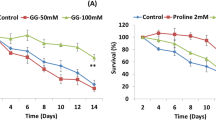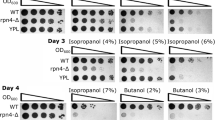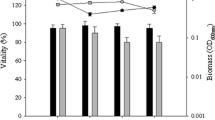Abstract
Glycerol is a key yeast metabolite in winemaking because it contributes to improve the organoleptic properties of wine. It is also a cellular protective molecule that enhances the tolerance of yeasts to osmotic stress and promotes longevity. Thus, its production increases by genetic manipulation, which is of biotechnological and basic interest. Glycerol is produced by diverting glycolytic glyceraldehyde-3-phosphate through the action of glycerol-3-phosphate dehydrogenase (coded by genes GPD1 and GPD2). Here, we demonstrate that RNA-binding protein Pub1p regulates glycerol production by controlling Gpd1p activity. Its deletion does not alter GPD1 mRNA levels, but protein levels and enzymatic activity increase, which explains the higher intracellular glycerol concentration and greater tolerance to osmotic stress of the pub1∆ mutant. PUB1 deletion also enhances the activity of nicotinamidase, a longevity-promoting enzyme. Both enzymatic activities are partially located in peroxisomes, and we detected peroxisome formation during wine fermentation. The role of Pub1p in life span control depends on nutrient conditions and is related with the TOR pathway, and a major connection between RNA metabolism and the nutrient signaling response is established.






Similar content being viewed by others
References
Adams A, Kaiser C, Cold Spring Harbor Laboratory (1998) Methods in yeast genetics: a cold spring harbor laboratory course manual, 1997 edn. Cold Spring Harbor Laboratory Press, Plainview, N.Y.
Anderson RM, Bitterman KJ, Wood JG, Medvedik O, Sinclair DA (2003) Nicotinamide and PNC1 govern lifespan extension by calorie restriction in Saccharomyces cerevisiae. Nature 423:181–185
Aranda A, Perez-Ortin JE, Moore C, del Olmo ML (1998) Transcription termination downstream of the Saccharomyces cerevisiae FPB1 poly(a) site does not depend on efficient 3’end processing. RNA 4:303–318
Balagopal V, Parker R (2009) Polysomes, P bodies and stress granules: states and fates of eukaryotic mRNAs. Curr Opin Cell Biol 21:403–408
Blomberg A, Adler L (1989) Roles of glycerol and glycerol-3-phosphate dehydrogenase (NAD+) in acquired osmotolerance of Saccharomyces cerevisiae. J Bacteriol 171:1087–1092
Borneman AR, Schmidt SA, Pretorius IS (2013) At the cutting-edge of grape and wine biotechnology. Trends Genet 29:263–271
Cambon B, Monteil V, Remize F, Camarasa C, Dequin S (2006) Effects of GPD1 overexpression in Saccharomyces cerevisiae commercial wine yeast strains lacking ALD6 genes. Appl Environ Microbiol 72:4688–4694
Delneri D, Wixon JL, Hutter A, Sefton M, Louis EJ, Oliver SG (2000) Exploring redundancy in the yeast genome: an improved strategy for use of the cre-loxP system. Gene 252:127–135
Duttagupta R, Tian B, Wilusz CJ, Khounh DT, Soteropoulos P, Ouyang M, Dougherty JP, Peltz SW (2005) Global analysis of Pub1p targets reveals a coordinate control of gene expression through modulation of binding and stability. Mol Cell Biol 25:5499–5513
Ehsani M, Fernández MR, Biosca JA, Julien A, Dequin S (2009) Engineering of 2,3-butanediol dehydrogenase to reduce acetoin formation by glycerol-overproducing, low-alcohol Saccharomyces cerevisiae. Appl Environ Microbiol 75:3196–3205
Engel A, Stahlberg H (2002) Aquaglyceroporins: channel proteins with a conserved core, multiple functions, and variable surfaces. Int Rev Cytol 215:75–104
Ferreira C, van Voorst F, Martins A, Neves L, Oliveira R, Kielland-Brandt MC, Lucas C, Brandt A (2005) A member of the sugar transporter family, Stl1p is the glycerol/H+ symporter in Saccharomyces cerevisiae. Mol Biol Cell 16:2068–2076
Gallo CM, Smith DL Jr, Smith JS (2004) Nicotinamide clearance by Pnc1 directly regulates Sir2-mediated silencing and longevity. Mol Cell Biol 24:1301–1312
Ghislain M, Talla E, Francois JM (2002) Identification and functional analysis of the Saccharomyces cerevisiae nicotinamidase gene, PNC1. Yeast 19:215–224
Gietz RD, Woods RA (2002) Transformation of yeast by lithium acetate/single-stranded carrier DNA/polyethylene glycol method. Methods Enzymol 350:87–96
Güldener U, Heck S, Fielder T, Beinhauer J, Hegemann JH (1996) A new efficient gene disruption cassette for repeated use in budding yeast. Nucleic Acids Res 24:2519–2524
Hohmann S (2002) Osmotic stress signaling and osmoadaptation in yeasts. Microbiol Mol Biol Rev 66:300–372
Jung S, Marelli M, Rachubinski RA, Goodlett DR, Aitchison JD (2010) Dynamic changes in the subcellular distribution of Gpd1p in response to cell stress. J Biol Chem 285:6739–6749
Kuman S, Singh R, Williams CP, van der Klei IJ (2016) Stress exposure results in increased peroxisomal levels of yeast Pnc1 and Gpd1, which are imported via a piggy-backing mechanism. Biochim Biophys Acta 1863(1):148–156
Kutyna DR, Varela C, Stanley GA, Borneman AR, Henschke PA, Chambers PJ (2012) Adaptive evolution of Saccharomyces cerevisiae to generate strains with enhanced glycerol production. Appl Microbiol Biotechnol 93:1175–1184
Longo VD, Shadel GS, Kaeberlein M, Kennedy B (2012) Replicative and chronological aging in Saccharomyces cerevisiae. Cell Metab 16:18–31
Longtine MS, McKenzie A 3rd, Demarini DJ, Shah NG, Wach A, Brachat A, Philippsen P, Pringle JR (1998) Additional modules for versatile and economical PCR-based gene deletion and modification in Saccharomyces cerevisiae. Yeast 14:953–961
Lopez de Silanes I, Galbán S, Martindale JL, Yang X, Mazan-Mamczarz K, Indig FE, Falco G, Zhan M, Gorospe M (2005) Identification and functional outcome of mRNAs associated with RNA-binding protein TIA-1. Mol Cell Biol 25:9520–9531
Melamed D, Pnueli L, Arava Y (2008) Yeast translational response to high salinity: global analysis reveals regulation at multiple levels. RNA 14:1337–1351
Miller GL (1959) Use of dinitrosalicylic acid reagent for determination of reducing sugar. Anal Chem 3:426–428
Oliveira R, Lages F, Silva-Graca M, Lucas C (2003) Fps1p channel is the mediator of the major part of glycerol passive diffusion in Saccharomyces cerevisiae: artefacts and re-definitions. Biochim Biophys Acta 1613:57–71
Orozco H, Matallana E, Aranda A (2012) Wine yeast sirtuins and Gcn5p control aging and metabolism in a natural growth medium. Mech Ageing Dev 133:348–358
Orozco H, Matallana E, Aranda A (2013) Genetic manipulation of longevity-related genes as a tool to regulate yeast life span and metabolite production during winemaking. Microb Cell Factories 12:1
Pahlman AK, Granath K, Ansell R, Hohmann S, Adler L (2001) The yeast glycerol 3-phosphatases Gpp1p and Gpp2p are required for glycerol biosynthesis and differentially involved in the cellular responses to osmotic, anaerobic, and oxidative stress. J Biol Chem 276:3555–3563
Picazo C, Orozco H, Matallana E, Aranda A (2015) Interplay among Gcn5, Sch9 and mitochondria during chronological aging of wine yeast is dependent on growth conditions. PLoS One 10:e0117267
Platta HW, Erdmann R (2007) The peroxisomal protein import machinery. FEBS Lett 581:2811–2819
Posas F, Chambers JR, Heyman JA, Hoeffler JP, de Nadal E, Arino J (2000) The transcriptional response of yeast to saline stress. J Biol Chem 275:17249–17255
Postma E, Verduyn C, Scheffers WA, Van Dijken JP (1989) Enzymic analysis of the Crabtree effect in glucose-limited chemostat cultures of Saccharomyces cerevisiae. Appl Environ Microbiol 55:468–477
Pretorius IS (2000) Tailoring wine yeast for the new millennium: novel approaches to the ancient art of winemaking. Yeast 16:675–729
Remize F, Sablayrolles JM, Dequin S (2000) Re-assessment of the influence of yeast strain and environmental factors on glycerol production in wine. J Appl Microbiol 88:371–378
Ribéreau-Gayon P, Dubourdieu D, Donèche B (2006) Handbook of enology, 2nd edn. John Wiley, Chichester, West Sussex, England; Hoboken, NJ
Riou C, Nicaud JM, Barre P, Gaillardin C (1997) Stationary-phase gene expression in Saccharomyces cerevisiae during wine fermentation. Yeast 13:903–915
Schrader M, Fahimi HD (2006) Peroxisomes and oxidative stress. Biochim Biophys Acta 1763:1755–1766
Siderius M, Van Wuytswinkel O, Reijenga KA, Kelders M, Mager WH (2000) The control of intracellular glycerol in Saccharomyces cerevisiae influences osmotic stress response and resistance to increased temperature. Mol Microbiol 36:1381–1390
Tamas MJ, Rep M, Thevelein JM, Hohmann S (2000) Stimulation of the yeast high osmolarity glycerol (HOG) pathway: evidence for a signal generated by a change in turgor rather than by water stress. FEBS Lett 472:159–165
Tilloy V, Ortiz-Julien A, Dequin S (2014) Reduction of ethanol yield and improvement of glycerol formation by adaptive evolution of the wine yeast Saccharomyces cerevisiae under hyperosmotic conditions. Appl Environ Microbiol 80:2623–2632
Valadi A, Granath K, Gustafsson L, Adler L (2004) Distinct intracellular localization of Gpd1p and Gpd2p, the two yeast isoforms of NAD + −dependent glycerol-3-phosphate dehydrogenase, explains their different contributions to redox-driven glycerol production. J Biol Chem 279:39677–39685
Walker ME, Gardner JM, Vystavelova A, McBryde C, de Barros LM, Jiranek V (2003) Application of the reuseable, KanMX selectable marker to industrial yeast: construction and evaluation of heterothallic wine strains of Saccharomyces cerevisiae, possessing minimal foreign DNA sequences. FEMS Yeast Res 4:339–347
Wei M, Fabrizio P, Madia F, Hu J, Ge H, Li LM, Longo VD (2009) Tor1/Sch9-regulated carbon source substitution is as effective as calorie restriction in life span extension. PLoS Genet 5:e1000467
Zuzuarregui A, del Olmo ML (2004) Expression of stress response genes in wine strains with different fermentative behavior. FEMS Yeast Res 4:699–710
Author information
Authors and Affiliations
Corresponding author
Ethics declarations
This article does not contain any studies with human participants or animals performed by any of the authors.
Funding
This work has been funded by grants from the Spanish Ministry of Science (AGL2011-24,353 and AGL2014-52984R). C.P. has a FPI fellowship.
Conflict of interest
The authors have declared that no competing interests exist.
Electronic supplementary material
ESM 1
(PDF 124kb)
Rights and permissions
About this article
Cite this article
Orozco, H., Sepúlveda, A., Picazo, C. et al. RNA binding protein Pub1p regulates glycerol production and stress tolerance by controlling Gpd1p activity during winemaking. Appl Microbiol Biotechnol 100, 5017–5027 (2016). https://doi.org/10.1007/s00253-016-7340-z
Received:
Revised:
Accepted:
Published:
Issue Date:
DOI: https://doi.org/10.1007/s00253-016-7340-z




